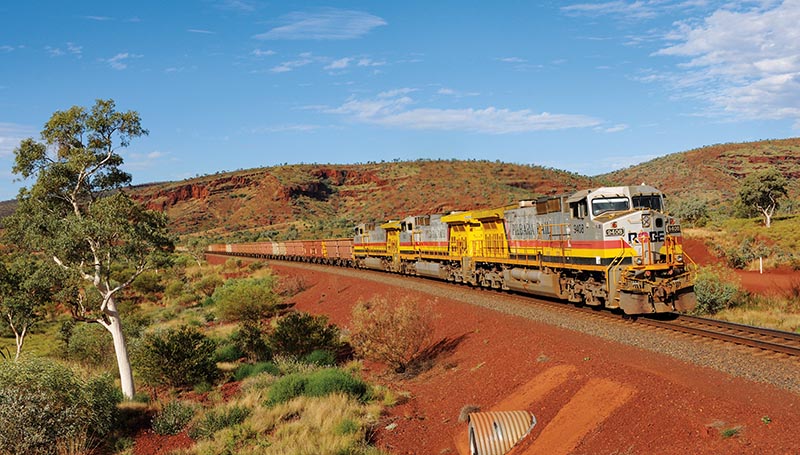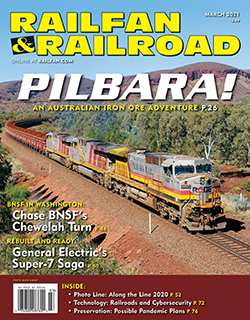 By Kevin EuDaly/photos by the author
By Kevin EuDaly/photos by the author
Sometime in the early 2000s, good friend Mel Wilson and I started talking about a trip to the Pilbara region in Western Australia. The Pilbara was particularly appealing because of the massive nature of the iron ore operations there — our kind of railroading. The trip became a reality when we took off from Los Angeles for Auckland, New Zealand, on May 17, 2011. After three days of shooting on New Zealand’s North Island, we headed for Perth and a rendezvous with longtime friend John Benson, who was our planner and guide, having been to Australia and the Pilbara many times. We arrived in the evening, and John had already gotten a room and a rental car, a Nissan X-Trail (with insurance, which we all agreed to), so we were set for an adventure. John guaranteed us two things before the trip — there would be no clouds in the Pilbara because it was early winter, and we’d see no snakes because they’d be hibernating.
We spent the following day railfanning around Perth, and about dusk started the long drive north to the Pilbara. After several hours of driving things get a little hazy, but the sequence of events remains vivid. First, one must realize that we were driving through a very remote region, where a cluster of lights, buildings, a gas station, and sometimes a motel (collectively known as roadhouses) were arranged about 200 miles apart. Our route was north on 95 toward Newman to Auski Roadhouse, 854 miles away. In the dark at one of those clusters of lights (which happened to be Wubin), we somehow missed a right turn and wound up on Mullewa-Wubin Road, a secondary road going northwest instead of 95 going northeast, and the brush started narrowing in from either side. We instituted the “second man nighttime driving rule” — extra eyes on the lookout.
From my vantage point in the back seat, with John driving to my right (steering wheels are right-handed in Australia) and Mel in front of me, I could see very little in the headlights ahead and was dozing off and on. John started mumbling something about this being the wrong road, and was obviously getting more uncomfortable and agitated. Somewhere south of Perenjori just shy of midnight, without warning, out of the air above the car came the roo — a large Western Red kangaroo — and he landed right in front of the car. Wham! John screamed, “Oh Gawd!” I saw puffs of smoke coming from just to the left of Mel’s head. We skidded to a stop. We hadn’t passed or seen another vehicle for at least an hour. The feeling was completely indescribable — something between terror and panic with a sinking feeling in the gut.
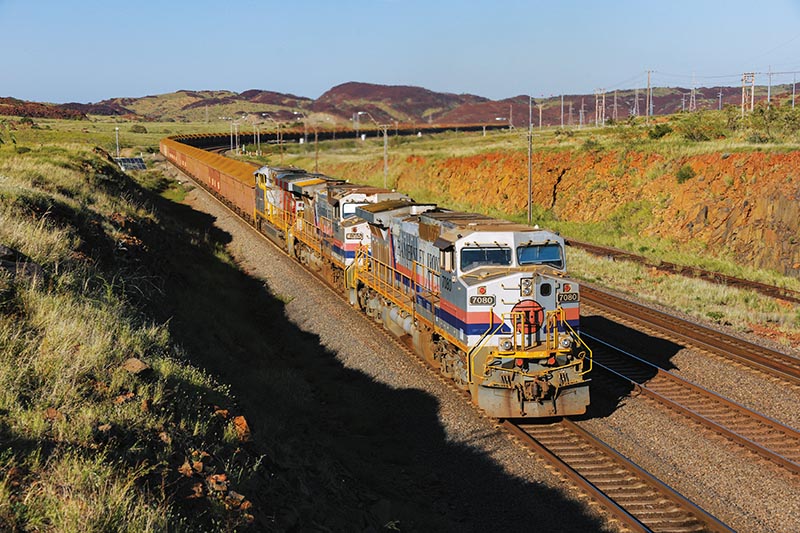
Day 10, June 2: Two Hamersley Iron C44-9Ws, 7080 and 7065, lead a Rio Tinto ES44DCi on a northbound loaded train arriving at Port Dampier at 9:36am.
We all got out of the car and John began a truly magnificent string of expletives at the top of his lungs into the night air — for 20 minutes straight! Yosemite Sam would be proud. It was surreal. Napoleon once said that to win any battle all you need is the loudest gun, and was famed for winning battles when drastically outnumbered because he had the most cannons. If a war was won or lost with expletives, that 20 minutes in the Pilbara couldn’t be defeated. John’s tirade was understandable in hindsight — he’d been to Australia 20-some-odd times and had a couple of very excited fellow Americans to show the Pilbara, and this was going to lose us at least a day getting the car towed to Geraldton, and maybe two or three.
It appeared to be a disaster. But it’s only a disaster if you’re forced to surrender, and our hands weren’t quite in the air yet. While John was screaming into the night air, Mel inspected the car while I walked around the vehicle and happened to find the plastic Nissan emblem that had been knocked off the front of the car by the roo. It holds an important place on my office wall to this day, a memento from a historic trip! When Mel concluded that the radiator wasn’t leaking, John’s tirade came to an end; otherwise, he might be there to this day, shrieking up a storm.
Upon close inspection the car was drivable, so after consulting a map (Mel proved his resourcefulness by bringing one) and figuring out exactly where we were (or where we hoped we thought we might be), we plotted a course to get back to 95. The roo, unfortunately, would plot no more courses. Our detour was a significant one, and ended up costing us about an hour-and-a-half, but that sure beat losing days getting the car replaced.
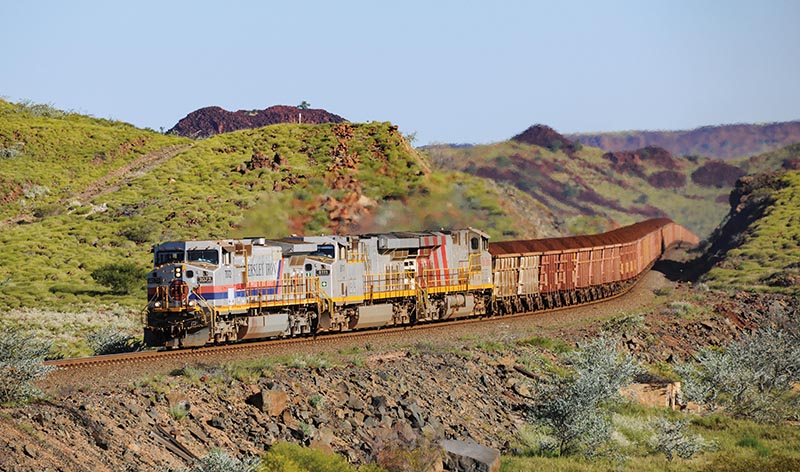
Day 5, May 28: Another day on Rio Tinto and we nabbed this northbound train of loads at Harding at 4:18pm. In the lead is C44-9W 7072 in Hamersley Iron paint, followed by ES44DCi 8111 in Rio Tinto solid silver and ES44DCi 8127 in the “stripes” scheme. Note that there are no taconite pellets in the Pilbara; it’s all refined raw ore being hauled.
We soon learned what the puff of smoke was. It was the equivalent of airbags in the seat belts, which decelerate the seat belts to keep occupants from slamming into them. Unfortunately, once the airbags go off and the belts retract, they can’t be freed up, so it was “really tight” seat belts for the front seat occupants from then on, which meant, as the smallest of the three, I did most of the driving because I was the only one who could slip into the driver’s side seat belt. Our trip to the Pilbara started out with a bang, literally.
We drove through the night, one headlight pointed off into the brush, and made it across the Tropic of Capricorn, just south of Newman, at 9:40 the next morning. Before long we were finally on an iron ore railroad in the Pilbara, BHP-Billiton (Broken Hill Proprietary merged with Billiton in 2001). We were all thankful to be railfanning and not stuck hundreds of miles south with a disabled car. At our first gas stop after daylight we bought duct tape and baling wire and put the front end back together, sort of — at least we got the headlights pointed mostly straight.
Later that morning I was driving, covering some of those miles heading north with John and Mel napping, when an emu darted across the road in front of us. I slammed on the brakes, yelled, and startled John and Mel out of their haze. An emu can easily take out a windscreen (Australian for windshield). We managed to dodge a second bullet. What next? We knew there would be more.
There were three iron ore railroads in the Pilbara in 2011:
BHP traces its roots in the Pilbara to two predecessors. Goldsworthy Mining began hauling ore on the route east of Port Hedland in 1968, and Mount Newman Mining built the main line south to Newman and started hauling ore in 1967. Both were owned by BHP, which currently operates the main line from Nelson Point in Port Hedland to five mines in the Newman area. Motive power is now exclusively SD70ACe and SD70ACe/LCi locomotives (the LCi stands for low clearance international, and is an export model), but while we were there in 2011 it still operated some GEs. The former Goldsworthy line from Port Hedland to Yarrie is currently not in operation, ceasing ore output in 2014.
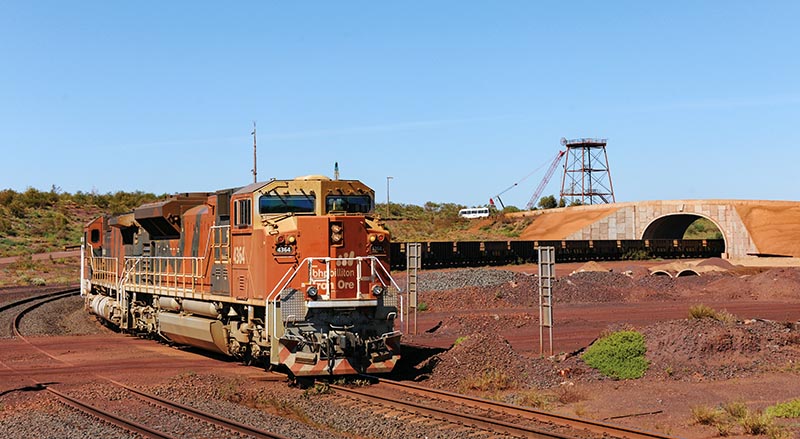
Day 4, May 27: BHP SD70ACe 4364 and AC6000 5655 pull through the unloader at Port Hedland at 12:37pm. BHP can unload two trains simultaneously. The remaining seven AC6000s on the roster, 6071–6077, were all scrapped in October 2014. As noted earlier, the 6070 was wrecked and scrapped in May 2011. This paint scheme is known as the “bubble” scheme.
Rio Tinto Iron Ore includes predecessors Hamersley Iron, which began operations in 1966, and Cliffs Robe River Iron Associates, which started in 1972. Hamersley’s main line ran from Dampier through Tom Price to Paraburdoo, while Robe River’s main line ran from Cape Lambert to mines near Pannawonica. Thus Rio Tinto operates port facilities at Cape Lambert and Dampier, both in the Karratha area. The two lines meet and cross at Western Creek Junction near Emu.
Fortescue Metals Group (FMG) was founded in 2003 and built a line from Finucane Island in Port Hedland to mines at Cloudbreak and Christmas Creek. The first shipload of iron ore from FMG mines occurred in May 2008. FMG has a variety of motive power including C44-9W, SD70ACe/LCi, and SD90MAC-H2 models.
Back in our somewhat damaged car, we landed our first shots at inappropriately named Garden on BHP, loads headed north toward Port Hedland. The language in Australia has quite a few nuances compared to our American English, generally following British terminology, and to illustrate, this was an “up” train (we’d say northbound in this case — up is generally toward a main terminal) with two “rakes of wagons” (we’d say cuts of cars) and two sets of power, all hooked together into a monstrous 35,000-ton train. Oh, and John’s first guarantee was a fail — there were clouds… lots of them. More of a problem than the clouds, we ran into a huge track gang working on a significant “duplication” (double-tracking) project and had to vacate BHP, so it was off to FMG, which crosses BHP at Woodstock.
We caught one FMG southbound with empties headed for one of the mines late in the afternoon, got another shot of the BHP train we’d shot at Garden, and shot a BHP three-rake train of empties headed south and the day was done. Not a particularly stellar introduction, but we made it to Auski Roadhouse in one piece, even though our car was in several pieces…


